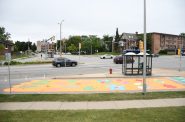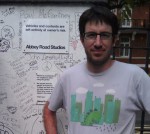A Subway Crisis, Mall Lots and Laser Data
All the city news you can use.
![An R160A E train boards and alights customers at 42 Street-Port Authority Bus Terminal. Photo by AEMoreira042281 (Own work) [CC BY-SA 3.0 (http://creativecommons.org/licenses/by-sa/3.0)], via Wikimedia Commons.](https://urbanmilwaukee.com/wp-content/uploads/2017/07/NYC_Subway_R160A_9237_on_the_E.jpg)
An R160A E train boards and alights customers at 42 Street-Port Authority Bus Terminal. Photo by AEMoreira042281 (Own work) [CC BY-SA 3.0 (http://creativecommons.org/licenses/by-sa/3.0)], via Wikimedia Commons.
New York’s subway is in crisis: The New York City subway’s reliability continues to drop, and there are endless reasons for the decline. But one of the biggest is deferred maintenance and past accidents that have led to train drivers taking extra precautions. Alon Levy goes through the history and issues causing the problems, letting everyone know the issue is not “crowding.” (Vox)
Oregon passes a bike tax: The state of Oregon recently passed a major transportation bill that includes the ability to toll interstates and tax new bicycle purchases. Local bicycle advocates aren’t happy and believe this move will do nothing to quell the argument that “cyclists don’t pay thier fair share.” (Bike Portland)
How to redevelop unused mall parking: Real estate companies are starting to realize the untapped assets they own next to suburban shopping malls around the country. REIT, the country’s largest shopping center investment trust, estimates that 75% of its land is tied up in parking, and that a lot of it just sits empty most of the time. Empty lots will now be a target for redevelopment at 50 Macy’s stores around the country. (Modern Cities)
Maybe tech giants can actually fix our transportation problems: Technologists can come up with all sorts of fantastic ideas, but often just to work toward getting themselves away from the masses who are idling in traffic. Alissa Walker argues that the biggest thing they can really help with is changing existing transportation policy that’s stuck in the political mud. (Curbed)
This is one big set of laser data: NYU has released an extensive LiDAR database to the public for use in research and policy development. LiDAR uses lasers to create 3D maps of cities urban fabrics. (Tech Crunch)
Quote of the Week:
As an exercise designed to lead to conversations about gentrification and displacement, safety and perception, [avoidance mapping is] a lens through which to look at bias, belonging, and other subjects. It’s useful (seeing how knowledge of and belonging to a place lead you to be able to successfully navigate it), provocative (what and whom you avoid says as much about you as the avoidances themselves), and creative (allowing us to foreground new, perhaps competing narratives of the city).
– Aaron Landsman discusses “avoidance mapping,” the practice of drawing out the places in your neighborhood that you deliberately don’t go to, at Urban Omnibus.
Sign-Up for More
Enjoy these links? Sign up for a free trial of The Direct Transfer Daily now and get 30 news items in your inbox each morning!
Urban Reads
-
Congestion Pricing Cuts Air Pollution in New York City
 Dec 14th, 2025 by Jeff Wood
Dec 14th, 2025 by Jeff Wood
-
We Think We Love to Drive. But Do We Really?
 Dec 7th, 2025 by Jeff Wood
Dec 7th, 2025 by Jeff Wood
-
Can Scott Wiener Tackle America’s Housing Crisis?
 Nov 23rd, 2025 by Jeff Wood
Nov 23rd, 2025 by Jeff Wood





















Yes, it`s a very big problem in our city!